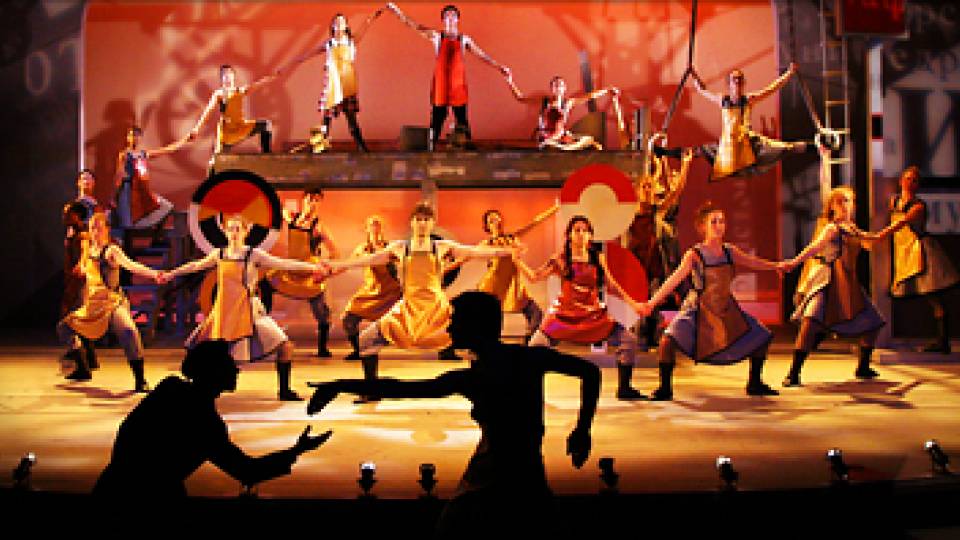Scholars from Princeton University and other institutions are painstakingly re-creating the choreography, costumes and elaborate mechanical set of one of the great lost ballets of the 20th century, "Le Pas d'Acier" or "The Steel Step" by legendary Russian composer Sergei Prokofiev. They will bring the ballet to life exactly the way Prokofiev intended it in three performances at the University's Berlind Theatre on April 7, 8 and 9.
"This is essentially a world premiere because the ballet was never performed the way Prokofiev conceived it," said assistant professor of music Simon Morrison, the mastermind behind the project, which has consumed him for the last three years.
Prokofiev, arguably the most popular composer of the 20th century, is the author of classics such as "Peter and the Wolf" and "Cinderella." The little-known "Pas d'Acier" was written as a dramatic tale about factory life after the Russian Revolution, a celebration of Soviet industrialization that Prokofiev hoped would endear him to Russian authorities. But budget constraints and a change in choreographers led to a scaled-down version of the ballet being performed in Paris in 1927 by the Ballets Russes, one of the most influential dance troupes of the 20th century. That version of the ballet mocked industrial development instead of lauding it.
"'Pas d'Acier' caused a political scandal when it debuted in 1927 because it ended up as a satire of Soviet society," Morrison said. The ballet has not been performed since 1931.
Putting on Prokofiev's lost ballet was little more than a dream when Morrison began raising funds for the project in 2002. Now, with support from several University departments, Morrison is producing a full-scale ballet with 30 dancers and 60 musicians, all Princeton students, as well as a magnificent set and custom-made costumes.
The visually spectacular set, created with the help of theater historian Lesley-Anne Sayers, is a replica of the one that originally was planned for the ballet by Georgi Yakoulov. It is a stylized mechanical world of brightly colored spinning wheels, gears, levers and a rotating conveyor belt representing factory life. An eight-foot-tall replica of a train that emits steam from its funnel will come into view partway through the ballet.
The ballet's choreography has been recreated using action cues and stage direction from the original musical score as well as drawings and photos discovered by Sayers in archives in Paris, London and Armenia.
The dancers will be drawn from an advanced contemporary dance class taught by ballet reconstructionist Millicent Hodson, who is a visiting fellow of the Humanities Council, and Rebecca Lazier, a lecturer in the Humanities Council and theater and dance.
The University Orchestra, under the direction of Michael Pratt, will perform Prokofiev's score, which contains a number of musical gestures that translate into movements on the stage.
"At this moment in his career Prokofiev was encoding choreography into his score," said Morrison, an expert on Russian music who has spent years researching lost ballet choreographies. "It's very carefully scripted to match the action on the stage."
At one point, for example, the score requires the 12 cellists to move their bows in sync "so they look like robots, echoing the ballet's industrial theme," Morrison said. "It's a wonderful effect."
The production is providing an opportunity for students to study the way music and choreography work together to communicate an author's vision. For Princeton faculty members and outside scholars, the ballet is a chance to bring their scholarly work to life.
"Le Pas D'Acier" will be performed at 8 p.m. on April 7, 8 and 9 at the Berlind Theatre. Three short pieces thematically related to the ballet, created by University composers and choreographers and others, will open the production: " In the Moment," with music by Paul Lansky and choreography by Mark Haim; "Island," with choreography by Ze'eva Cohen and music by Igor Stravinsky; and "Repetition Compulsion," with music by Barbara White and choreography by Terry Araujo. In the first half of the April 8 program, a fourth piece, "Transparent Body," with choreography by Rebecca Lazier and music by Dan Trueman, will be performed.
More information on the project is available online. To buy tickets, call (609) 258-2787.




